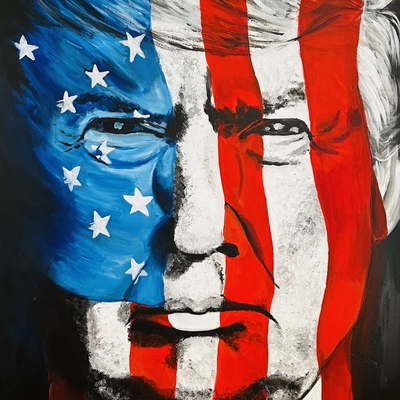Stay informed on the latest Truth Social posts from Donald Trump (@realDonaldTrump) without the doomscrolling. Consider it a public service for your mental health. (Why?)
- President Donald Trump and Russian President Vladimir Putin are together.
- They are watching F-35 fighter jets.
- The event occurs at Joint Base Elmendorf-Richardson in Anchorage, Alaska.
- The event takes place on August 15, 2025.
The post describes a future event on August 15, 2025, involving the US and Russian presidents observing US F-35 fighter jets. Such an event, if widely anticipated or announced, would signify a major geopolitical development. This could impact defense company valuations due to potential changes in procurement, alliance structures, or international military sales. It could also influence energy markets given Russia's significant role as a producer, and alter overall market risk sentiment, affecting sectors sensitive to international relations and trade. The '2025' date implies a future policy direction that, if expected, would begin to be priced into various market sectors, particularly defense and energy.
The post depicts the US and Russian presidents jointly observing F-35 fighter jets in Alaska in 2025. This interaction suggests a potential shift in US-Russia relations, possibly towards cooperation or a new form of strategic engagement. While F-35s represent military power, their joint observation does not inherently indicate an immediate threat or ultimatum for international conflict escalation. Instead, it points to a future scenario of direct engagement between these leaders regarding military capabilities, which could reshape alliances or understandings without necessarily escalating existing conflicts.
- Commodities: Gold (XAU) could see initial volatility, potentially rising as a safe-haven if the geopolitical realignment is perceived as destabilizing, or experiencing a sell-off if it signals a new era of perceived stability. Oil (WTI) would be highly sensitive, given Russia's role as a major producer; a significant shift in US-Russia relations could ease supply fears or change pricing dynamics related to sanctions. Short-Term Watchlist: XAU/USD price action, WTI price reaction based on perceived shifts in Russia-US energy policy or sanctions outlook. Medium-Term Focus: Geopolitical risk premium in oil, long-term energy alliance shifts, potential impact on industrial metal demand if global economic outlook shifts.
- Currencies (Forex): The US Dollar Index (DXY) could react to changes in global risk sentiment. If the event is seen as a move towards greater stability or a new US foreign policy stance, the dollar's safe-haven status could be affected. USDJPY, EURUSD, and other pairs would reflect shifting risk appetites and central bank policy expectations based on the new geopolitical landscape. Short-Term Watchlist: DXY volatility, reaction to global risk sentiment. Medium-Term Focus: Changes in global capital flows, potential central bank policy divergence based on the evolving geopolitical environment.
- Global Equities: S&P 500, Nasdaq, STOXX 600, Nikkei 225, and Hang Seng would all be impacted. Defense stocks (e.g., Lockheed Martin, Raytheon) would be directly affected by perceived changes in US defense posture or international military sales. Energy stocks could see shifts in valuation. Broader market sentiment could be affected, leading to sector rotations depending on whether the event is interpreted as risk-on or risk-off. Short-Term Watchlist: Defense sector performance, broader market sentiment shift, particularly in sectors sensitive to international relations. Medium-Term Focus: Sector rotation, re-evaluation of geopolitical risk premiums across various equity markets.
- Fixed Income (Bonds): US 10Y and 2Y yields could react to changes in global risk perception and potential fiscal implications of new defense or foreign policy. A significant geopolitical shift could trigger flight-to-safety flows into US Treasuries if uncertainty rises, or a sell-off if confidence improves significantly and risk appetite returns. Credit spreads may widen if uncertainty dominates. Short-Term Watchlist: UST 10Y yield levels, credit spread movements. Medium-Term Focus: Changes in inflation expectations, fiscal policy outlook, flight-to-safety demand for US debt.
- Volatility / Derivatives: The VIX could spike initially due to uncertainty surrounding such a major geopolitical development, or compress if the event is interpreted as a move towards de-escalation or clearer policy. Options positioning would adjust to reflect increased tail risks or new policy expectations. Short-Term Watchlist: VIX levels versus VIX futures term structure. Medium-Term Focus: Volatility regime shifts based on sustained geopolitical changes and policy implications.
- Crypto / Digital Assets: Bitcoin (BTC) might behave as a risk-on asset initially, correlating with tech stocks, or as a macro hedge if the geopolitical shift leads to broader economic uncertainty. Its reaction would depend on the overall market's interpretation of the event (risk-on vs. risk-off). Short-Term Watchlist: BTC/USD price action, correlation to traditional risk assets. Medium-Term Focus: Impact on stablecoin flows, regulatory sentiment based on broader geopolitical stability.
- Cross-Asset Correlations and Systemic Risk: A significant geopolitical shift could challenge existing cross-asset correlations, potentially leading to situations where both equities and bonds sell off (risk-off with inflation concerns) or unexpected realignments in asset behavior. Could reveal underlying market plumbing stress if the shift is disruptive or unexpected. Short-Term Watchlist: Breakdowns in normal correlations, liquidity stress in specific markets. Medium-Term Focus: Re-evaluation of systemic risks, central bank responses to a new geopolitical/economic landscape.
- Retail Sentiment / Market Psychology: Such a high-profile, potentially paradigm-shifting event involving two major global leaders would likely generate significant discussion and speculation across retail trading platforms and social media. This could lead to concentrated interest in specific sectors (e.g., defense ETFs, energy stocks) or influence broader market sentiment among retail investors. Short-Term Watchlist: Social media trends related to geopolitics and specific sectors. Medium-Term Focus: Sustained retail interest in themes related to new foreign policy, defense spending, and international alliances.

